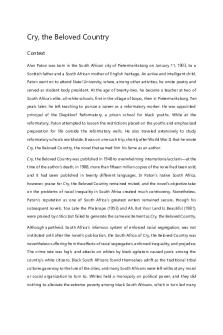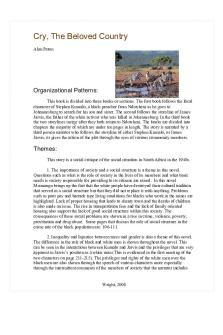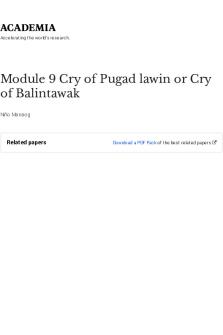The First Cry of Revolution; Synopsis PDF

| Title | The First Cry of Revolution; Synopsis |
|---|---|
| Course | History |
| Institution | Central Mindanao University |
| Pages | 2 |
| File Size | 54.1 KB |
| File Type | |
| Total Downloads | 40 |
| Total Views | 245 |
Summary
A summary of the First Cry of Revolution...
Description
The First Cry of Revolution: Synopsis
The first cry is a historical event where the Filipinos tore their cedulas which for Andres Bonifacio is the sign of the slavery of the Filipinos to the Spaniards. This Philippine Revolution of 1896 happened after the secret organization of the Filipinos or the Katipunan was exposed to the Spaniards and the members were tracked and many were imprisoned. With regards to this situation, the Supremo became worried about his comrades and their ultimate goal to be compromised. Bonifacio decided to hold a meeting outside the city with the agenda of when to carry out their plan to attack the Spanish government. In 1911, a monument of the heroes of the Philippine Revolution that was believed to happen there on August 26 was built in Balintawak. However, different Katipunan personalities contradicted the time and place of the First Cry of the Philippine Revolution, among them were Pio Valenzuela, Santiago Alvarez, and Guillermo Magsangkay. Based on the accounts of Pio Valenzuela, a friend of Bonifacio and a member of the Katipunan, the first place of refuge of the Katipunan was in Balintawak specifically at the house and yard of Apolonio Samson at Kangkong on August 22, 1896. Among himself were Andres Bonifacio, Procopio Bonifacio, Emilio Jacinto, Teodoro Plata, and Agueldo del Rosario. There was no big decision made there rather only views were exchanged. It was in the store-house and yard of Juan Ramos at Pugad Lawin on August 23, 1896 where they debated whether the revolution against the Spanish government was to be started or not on August 29, 1896. Only Teodoro Plata protested and fought against a war. After the intense debate, the people tore their cedula certificates and shouted “Long live the Philippines! Long live the Philippines!” The account of Santiago Alvarez, one of the leaders of the Cavite revolution with a pen name Kidlat ng apoy, stated that they went through a tiring journey to the house of Apolonio Samson at Kangkong. On August 22, 1896, the Supremo assigned guards and placed detachment at the Balintawak boundary where they are gathered. There were more than three hundred people assembled at the place carrying assorted weapons. The Supremo was worried of the possibilities that there might be a surprise attack from the enemy so he decided to move to a site called Bahay Toro. They arrived at the residence of Cabesang Melchora on August 23, 1896. The number of the Katipuneros increased and the house, yard, and warehouse of Cabesang Melchora were crowded. At ten o’clock, the Supremo called a meeting inside the barn but due to their number, some stood outside the barn. On both sides of the Supremo were Dr. Pio Valenzuela, Emilio Jacinto, Briccio Pantas, Enrique Pacheco, Pantelaon Torres and others. The approved matters were: an uprising to defend the peoples freedom was to be midnight of Saturday August 29, 1896; to be on a state of alert so that the Katipunan forces could strike where the enemy was at its disadvantage, thus the uprising could be on an earlier than the agreed time of midnight of August 29, 1896; and the capture of Manila. After the meeting was adjourned, there were loud shouts “Long live the Sons of the People!”
According to the account of Guilllermo Magsangkay, a friend and fellow Katipunero of Bonifacio, the uprising happened on August 26, 1896. The same date, a big meeting was held at the Balintawak in the house of Apolonio Samson with the presence of Andres Bonifacio as the presider, Emilio Jacinto as the secretary, Aguedo del Rosario, Tomas Remigio, Briccio Pantas, Teodoro Plata, Pio Valenzuela, and others. The goal of the meeting was to decide when the uprising was to take place. Plata, Pantas, and Valenzuela opposed to the idea of starting the revolution too early and without adequate preparation. Bonifacio went outside the hall and told to the people about the argument of the leaders inside and delivered a speech in which he talked about whether they wait for the Spaniards to shoot them or start the uprising early since there sedition to the Spain was discovered. The people sided with him and shouted “Revolt.” Bonifacio then asked the people to pledge to revolt through destroying their cedulas. When he obtained the pledge of the people, he went back inside and told the leaders that the people want revolt and if they were not to start the uprising early, hundreds might be shot. The board of the directors voted for revolution despite the protests of Plata, Pantas, and Valenzuela. This was decided and the people shouted “Long Live the Philippine Republic.” According to the account of Alvarez, it was on August 24, 1896 that the First Cry takes place. However, account of Magsangkay contradicted and stated that the First Cry happened on August 26, 1896 at Balintawak, and this was used by the government to fix the date and place of the First Cry following the erection of the “Monument of the Heroes of 1896” in that place. In 1963, the National Historical Commission of the Philippines upon extensive research of the primary sources declared that the First Cry of the Philippine Revolution happened on August 23, 1896 at Pugad Lawin. The official date and place of the First Cry was largely based on the account of Pio Valenzuela, who was present during the event....
Similar Free PDFs

CRY-of-Rebellion - nnnkjnjnknn
- 2 Pages

Cry, the Beloved Country Cry - Diary
- 12 Pages

Effects of the Sugar REvolution
- 4 Pages

Summary-Cry of Rebellion
- 3 Pages

The no Cry Sleep Solution.pdf
- 273 Pages

Synopsis
- 1 Pages

Objectives of the first crusade
- 4 Pages

Cry, the Beloved Country - Diary
- 7 Pages
Popular Institutions
- Tinajero National High School - Annex
- Politeknik Caltex Riau
- Yokohama City University
- SGT University
- University of Al-Qadisiyah
- Divine Word College of Vigan
- Techniek College Rotterdam
- Universidade de Santiago
- Universiti Teknologi MARA Cawangan Johor Kampus Pasir Gudang
- Poltekkes Kemenkes Yogyakarta
- Baguio City National High School
- Colegio san marcos
- preparatoria uno
- Centro de Bachillerato Tecnológico Industrial y de Servicios No. 107
- Dalian Maritime University
- Quang Trung Secondary School
- Colegio Tecnológico en Informática
- Corporación Regional de Educación Superior
- Grupo CEDVA
- Dar Al Uloom University
- Centro de Estudios Preuniversitarios de la Universidad Nacional de Ingeniería
- 上智大学
- Aakash International School, Nuna Majara
- San Felipe Neri Catholic School
- Kang Chiao International School - New Taipei City
- Misamis Occidental National High School
- Institución Educativa Escuela Normal Juan Ladrilleros
- Kolehiyo ng Pantukan
- Batanes State College
- Instituto Continental
- Sekolah Menengah Kejuruan Kesehatan Kaltara (Tarakan)
- Colegio de La Inmaculada Concepcion - Cebu







